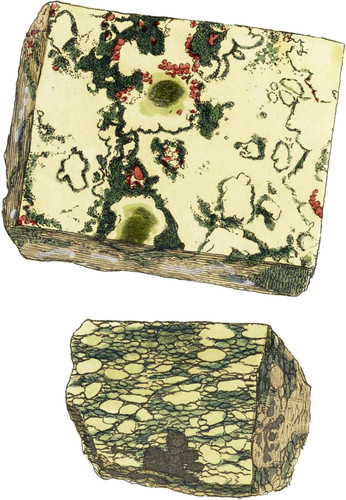 Enlarge
Enlarge
British Mineralogy
Indurated Steatite
- Class 2. Earths.
- Order 1. Homogeneous.
- Gen. 4. Silex.
- Spec. 13. Steatites.
- Div. 3. Amorphous.
Perhaps this substance may have so much resembled Porcelain, that when polished it might be mistaken for natural Porcelain, and it may possibly be very nearly the same in regard to the component parts, especially with that which is made of Petuntse and Kaolin. The present specimen from Portsoy must be allowed to be softer than the Porcelain, but would nevertheless become harder by being heated. It is chiefly composed of Silex, Alumine, and Magnesia, like the last substance, but in a harder state, and the tints may give a lesson for a new way of preparing colours, if that were necessary, and may indeed be useful, though the colouring of Porcelain is now tolerably perfect. The colours in this seem chiefly to depend on Oxide of Iron in different states; thus the yellowish hue is owing to a mixture of a pale yellow Oxide in a small quantity, and the red to a mixture of very deep Oxide of Iron; but the green may arise from a mixture, as it were, of Chlorite. This is sometimes intimately mixed with Steatite, and is curiously dispersed about the present specimen in lines, spots, &c. Indeed these and the larger yellower spots are nearly the same in appearance with the Hatchet Stone of the Leeward Islands, called Nephrite, Jade, &c.; but known by its greater softness as Serpentine. This, therefore, includes a very interesting lesson, and I am obliged to Earl Seaforth for so handsome a specimen.
The lower specimen came from North Wales, and was sent me by the Rev. H. Davies : the Chlorite which holds some Pyrites in the veins or marbling of this, and the Pyrites with the rest of the substance, are not far from agreeing with the Meteor-stones.
Steatite and Serpentine differ but little except in the colour, which seems much to depend upon Iron. Steatite has been found in secondary crystals, chiefly in the form of those of Quartz.

